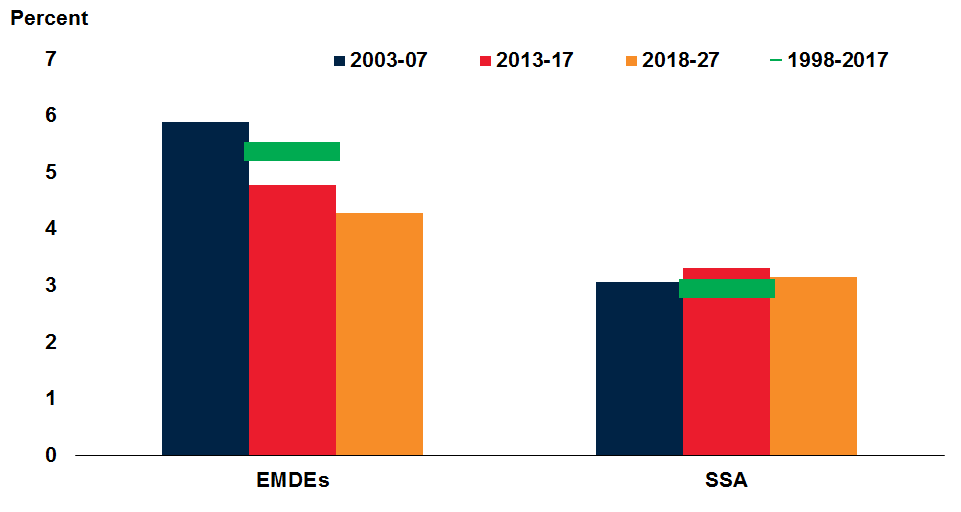The global economic recovery will see economic conditions improving in Sub-Saharan Africa. Activity is projected to pick up across the region over the forecast horizon, helped by firming commodity prices and gradually strengthening domestic demand. However, in the absence of reforms, potential growth is expected to remain low given demographic and investment trends, weighing on per capita incomes and diminishing the prospects for poverty reduction. Downside risks predominate, including the possibilities that commodity prices could remain weak, global financing conditions could tighten in a disorderly fashion, and that regional political uncertainty and security tensions could intensify. On the upside, a stronger-than-expected pickup in global activity could further boost exports, investment, and growth in the region.
Sub-Saharan Africa’s growth outlook is improving
Growth in Sub-Saharan Africa is projected to pick up to 3.2 percent this year from an estimated 2.4 percent in 2017 and 1.3 percent in 2016, and strengthen gradually. While Angola, Nigeria, and South Africa – the region’s largest economies — will struggle to boost growth, the performance of the rest of the region will be stronger.
Growth
Source: World Bank
Note: shaded areas represent forecasts
The outlook is partly buoyed by the likelihood of fiscal consolidation
Countries across the region are expected to push ahead with fiscal consolidation as external borrowing costs look set to rise. For countries like Angola, Kenya, and South Africa, 2018 will be a critical year for reining in large fiscal deficits, as failure to do so could see investor sentiment sour significantly.
Stabilizing weather conditions are also likely to support higher growth in 2018
A combination of drought and elevated political and policy uncertainty contributed to a slower-than-anticipated growth in several countries in 2017, particularly in East Africa. As these headwinds ease, moderately stronger growth is expected across East Africa in 2018, with the recovery in agriculture boosting activity.
Structural reforms would still be needed to boost potential growth over the medium-term
The region’s high fertility rates could slow the growth of the working-age population, and the weakening of the investment rate will moderate capital stock growth. Absent reforms, potential growth—which determines the rate at which an economy can expand—is likely to remain low over the next decade, below the average for emerging market and developing economies.
Sub-Saharan Africa potential growth

Source: World Bank staff estimates.
Notes: GDP-weighted averages. EMDE = Emerging market and developing economies.
A sustained increase in per capita potential growth is critical for poverty reduction
SSA’s potential growth could be boosted through policies to spur investment, improve education and health, and raise female participation rates. Excluding South Africa, potential growth could rise above the emerging market and developing economy average by 2027, as well as above the regional population growth rate, improving the prospect of gains in per capita incomes.
Sub-Saharan Africa potential growth under reform scenarios

Source: World Bank staff estimates
Notes: GDP-weighted averages.



Join the Conversation